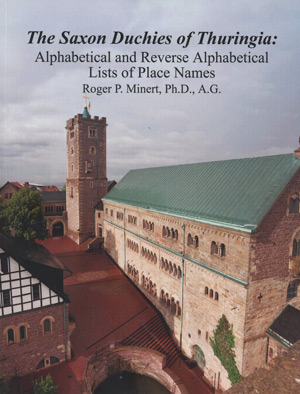This volume is the latest in Alphabetical and Reverse Alphabetical Lists of German Place Names volumes written by Roger Minert. It is made up of an alphabetical, as well as a reverse alphabetical index of the Saxon Duchies of Thuringia. Printed in December of 2019, this book is an important addition for anyone researching Thüringen roots.
For a list of earlier volumes, see below.
The Saxon Duchies of Thuringia: Alphabetical and Reverse Alphabetical Lists of Place Names; Roger P. Minert, Ph.D., A.G; December, 2019; Soft Cover, Perfect Bound; 64pp; ISBN: 978-1-62859-277-1; Item #: FR0602.
One of the finest examples of the geopolitical confusion caused by the feudal system in the German-language realm in central Europe is that of the so-called “Saxon Duchies” – the territory now called Thüringen [Thuringia]. In no other area of Germany have there been changes in so many borders and feudal allegiances as in this region of east central Germany.
The name Thüringen is derived from the first group of Germans to inhabit the region. Those people lost their independence when they were conquered by the Franks and the Saxons and were converted to Christianity in the eighth century. The family of Ludwig the Bearded gained control of the counties in the region by A.D. 1039 and were raised to the status of count in about 1130. Succeeding counts expanded their holdings to include areas of Hessen along the Wester and Leine Rivers as well as the Palatine County of Saxony. This clan died out in 1247 and many of its properties were ceded to other counties. The Wettiner family of Meissen regained their hold on the area in 1307, but they consolidated the remaining numerous small counties into one cohesive geopolitical entity.
A major distribution of the historic Thüringen properties occurred in 1485, but even more divisions and separations took place after 1572. In the meantime, the Protestant Reformation had been introduced throughout the region. By the end of the 17th century, the Thüringen lands were shared by (among others) no fewer than ten lines of the Ernestine counts, nine lines of the Reuss counts, and three lines of the Schwarzburg counts.
In the early 19th century some of the small Saxon Duchies were annexed by Prussia. The main survivors existing in 1815 were these: Schwarzburg (Rudolstadt and Sondershausen), Reuss (elder and younger lines), and the small states of Sachsen-Weimar-Eisenach, Sachsen-Coburg-Altenburg, Sachsen-Meiningen, Sachsen-Hildburghausen, Sachsen-Coburg-Saalfeld, Ebersdorf, Schleiz, and Lobenstein. In 1826, King Friedrich August of Saxony combined and re-named several of the states.
Following World War I, the princes of these small states were forced to abdicate. The eight remaining units (four Ernestine lines, two Schwarzburg, and two Reuss) joined together under the historic name Thüringen. The year was 1920 and Weimar was chosen as the capital city. A constitution was introduced a year later. The state was under Soviet military occupation from 1945 to 1949, when it was included in the new German Democratic Republic (commonly called East Germany). It was then divided into the administrative districts of Erfurt, Gera, and Suhl, but the unification with the Federal Republic of Germany (West Germany) saw yet another re-organization into counties.
The keeping of church records in the Saxon Duchies (dominated as they were by the Lutheran faith) began in the late 1500s. The majority of those records have survived the ravages of time and can be found in the original parish offices. As of this printing, very few of those records have been microfilmed or digitized.
The Following is from The Table of Contents
- Introduction
- Reuss ältere Linie [Reuss elder line] Alphabetical List
- Reuss ältere Linie [Reuss elder line] Reverse Alphabetical List
- Reuss jüngere Linie [Reuss younger line] Alphabetical List
- Reuss jüngere Linie [Reuss younger line] Reverse Alphabetical List
- Sachsen-Altenburg Alphabetical List
- Sachsen-Altenburg Reverse Alphabetical List
- Sachsen-Coburg-Gotha Alphabetical List
- Sachsen-Coburg-Gotha Reverse Alphabetical List
- Sachsen-Meiningen Alphabetical List
- Sachsen-Meiningen Reverse Alphabetical List
- Sachsen-Weimar-Eisenach Alphabetical List
- Sachsen-Weimar-Eisenach Reverse Alphabetical List
- Schwarzburg-Rudolstadt Alphabetical List
- Schwarzburg-Rudolstadt Reverse Alphabetical List
- Schwarzburg-Sondershausen Alphabetical List
- Schwarzburg-Sondershausen Reverse Alphabetical List
A reverse alphabetical index is key to doing research in the German parish registers. The Reverse Alphabetical Index allows the researcher to determine the name of a town when the first part of the name (whether one or more letters) is missing. This is a common problem caused by torn or moldy pages, ink-blots, tight bindings, poor microfilm quality, etc. By using this index, the researcher can also determine the official spelling for towns when variant spellings occur in old records. The book includes a regular alphabetical index of all the Duchies in the Thuringia.
Other “Identifying Place Names Using Alphabetical and Reverse Alphabetical Indexes” Published by Family Roots Publishing
- Alsace-Lorraine Place Name Indexes:
- Baden Place Name Indexes
- Bavaria Place Name Indexes
- Brandenburg Place Name Indexes
- Braunschweig/Oldenburg/Thuringia Place Name Indexes
- East Prussia Place Name Indexes
- Hanover Place Name Indexes
- Hesse Place Name Indexes
- Hesse-Nassau Place Name Indexes
- Mecklenburg Place Name Indexes
- Palatinate Place Name Indexes
- PDF Ebook: Palatinate Place Name Indexes
- Pomerania Place Name Indexes
- Posen Place Name Indexes
- Rhineland Place Name Indexes
- Kingdom of Saxony Place Name Indexes
- Province of Saxony Place Name Indexes
- Schleswig-Holstein (with Bremen/Hamburg/Lubeck) Place Name Indexes
- Silesia Place Name Indexes
- The Saxon Duchies of Thuringia
- West Prussia Place Name Indexes
- Westphalia (with Hohenzollern/Lippe/Schaumberg-Lippe/Waldeck) Place Name Indexes
- Württemberg Place Name Indexes
